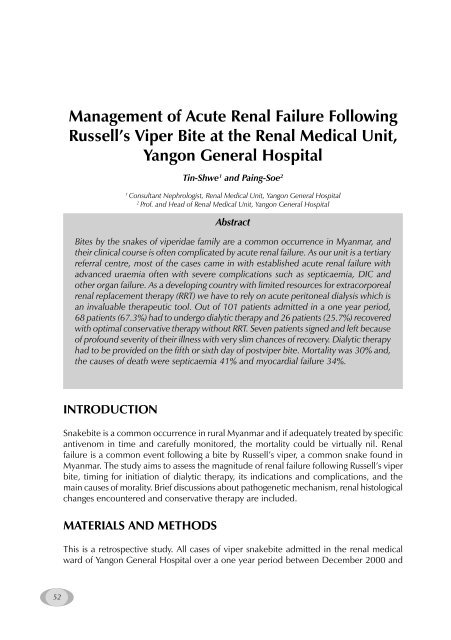Management of Snakebite and Research Management of Snakebite ...
Management of Snakebite and Research Management of Snakebite ...
Management of Snakebite and Research Management of Snakebite ...
Create successful ePaper yourself
Turn your PDF publications into a flip-book with our unique Google optimized e-Paper software.
<strong>Management</strong> <strong>of</strong> <strong>Snakebite</strong> <strong>and</strong> <strong>Research</strong><br />
52<br />
<strong>Management</strong> <strong>of</strong> Acute Renal Failure Following<br />
Russell’s Viper Bite at the Renal Medical Unit,<br />
Yangon General Hospital<br />
Tin-Shwe 1 <strong>and</strong> Paing-Soe 2<br />
1 Consultant Nephrologist, Renal Medical Unit, Yangon General Hospital<br />
2 Pr<strong>of</strong>. <strong>and</strong> Head <strong>of</strong> Renal Medical Unit, Yangon General Hospital<br />
Abstract<br />
Bites by the snakes <strong>of</strong> viperidae family are a common occurrence in Myanmar, <strong>and</strong><br />
their clinical course is <strong>of</strong>ten complicated by acute renal failure. As our unit is a tertiary<br />
referral centre, most <strong>of</strong> the cases came in with established acute renal failure with<br />
advanced uraemia <strong>of</strong>ten with severe complications such as septicaemia, DIC <strong>and</strong><br />
other organ failure. As a developing country with limited resources for extracorporeal<br />
renal replacement therapy (RRT) we have to rely on acute peritoneal dialysis which is<br />
an invaluable therapeutic tool. Out <strong>of</strong> 101 patients admitted in a one year period,<br />
68 patients (67.3%) had to undergo dialytic therapy <strong>and</strong> 26 patients (25.7%) recovered<br />
with optimal conservative therapy without RRT. Seven patients signed <strong>and</strong> left because<br />
<strong>of</strong> pr<strong>of</strong>ound severity <strong>of</strong> their illness with very slim chances <strong>of</strong> recovery. Dialytic therapy<br />
had to be provided on the fifth or sixth day <strong>of</strong> postviper bite. Mortality was 30% <strong>and</strong>,<br />
the causes <strong>of</strong> death were septicaemia 41% <strong>and</strong> myocardial failure 34%.<br />
INTRODUCTION<br />
<strong>Snakebite</strong> is a common occurrence in rural Myanmar <strong>and</strong> if adequately treated by specific<br />
antivenom in time <strong>and</strong> carefully monitored, the mortality could be virtually nil. Renal<br />
failure is a common event following a bite by Russell’s viper, a common snake found in<br />
Myanmar. The study aims to assess the magnitude <strong>of</strong> renal failure following Russell’s viper<br />
bite, timing for initiation <strong>of</strong> dialytic therapy, its indications <strong>and</strong> complications, <strong>and</strong> the<br />
main causes <strong>of</strong> morality. Brief discussions about pathogenetic mechanism, renal histological<br />
changes encountered <strong>and</strong> conservative therapy are included.<br />
MATERIALS AND METHODS<br />
This is a retrospective study. All cases <strong>of</strong> viper snakebite admitted in the renal medical<br />
ward <strong>of</strong> Yangon General Hospital over a one year period between December 2000 <strong>and</strong>









